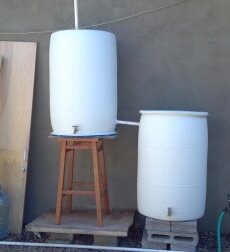Free water, but is it safe for water harvesting?
Q: I want to do more water harvesting. During the summer, my air conditioner condensate water runs off the roof through a pipe and drips onto the ground. Can I use this run-off to water my garden?
A: Yes, water harvesting using the air conditioner condensate water can be an extremely efficient method to conserve water and take care of ornamental plants. Condensate water is essentially distilled water that is safe for plants, though it may be corrosive to metals. It may contain heavy metals from the air conditioner coils with which it comes in contact, so don’t use it on edible plants if you are concerned about ingesting these metals that may be taken up into plant tissues. To be on the safe side, use the run-off water for ornamental plants only.
Water harvesting saves money and conserves precious water resources. Whether you have a whole house air conditioning system or window box, it drains water that you can collect for use. As an air conditioner runs, it pulls moisture from the air, which is drained outside the home, usually through a condensation pipe that directs the water away from the house. The water slowly drips from the pipe, and though it doesn’t seem like much water, the constant dripping adds up. This water can be caught in a bucket or catchment system, or directed to plants that are strategically placed below the dripping pipe.
Strategically Placed Plants
One way to harvest condensate water is to strategically place plants nearby the dripping pipe. If planting near a ground or first-floor window unit, choose plants that will grow only a few feet tall so they won’t grow over the unit. Plant varieties that like to be watered in the heat of summer, but that can go without much supplemental water in the winter, such as deciduous bushes or succulents. Dig a small flower bed or place plant containers below the condensate run-off pipe and they’ll get constant water over the summer as air conditioner runs.
Catchment Systems
If you would like to catch the water to use in other areas of your yard, there are several options available. Simply placing a bucket below the drip will capture several gallons of water each day. However, in an open bucket, some of the water will evaporate and the bucket will likely overflow, wasting water that could be used in the garden.
A more efficient option would be a commercial or professionally installed catchment system. However, these can be costly, so the benefits must be weighted against the long term benefits.
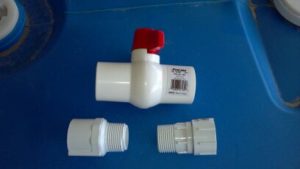 Make Your Own Catchment System
Make Your Own Catchment System
You can create a simple catchment system easily and inexpensively to collect condensate water. The system consists of a PVC pipe attached to the run-off pipe, a barrel, a spigot, and an optional second barrel for overflow. In order to make your system, you will need the following items:
- 1 or 2 plastic barrels (Used restaurant barrels work well. Search for them online via Google or Craig’s List. Rain barrels also work well, but are more expensive to purchase. Large Rubbermaid trash cans with lids are an additional option.)
- 3/4 or 1″ PVC pipe, long enough to connect the drip pipe to the barrel and to connect the two barrels together
- Gorilla Glue ( I prefer the original brown Gorilla Glue, but you can get clear glue if you prefer it)
- Silicone Plumbing Sealant (Such as Gorilla Glue Plumbing Sealant)
- Drill and hole saw bits or spade bore bits (1/4″, 3/4″ and 1″)
- Hacksaw
- 1 or 2 spigots (such as a 1/4″ ball valve)
- Rubber hose washers or o-rings
- Wrench
Prepare the Barrels
You can make a simple system with one barrel, or create an overflow system with 2 barrels. If the barrels are used or dirty, clean out the insid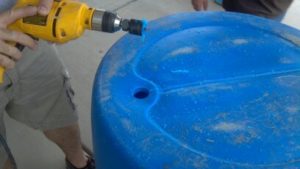 e of the barrels so that no debris will be washed into your spigot valves and clog them.
e of the barrels so that no debris will be washed into your spigot valves and clog them.
Drill holes the same diameter as your spigot valve connections. We used 3/4″ valves, so we drilled 3/4″ holes in which to insert them. The orange arrows on the photo guide below show where to drill.
Drill holes the same size as the diameter of your PVC pipe. Holes are placed at the yellow arrows on the photo guide below.
Drill Spigot and P ipe Holes
ipe Holes
Orange arrows signify where to drill holes for spigot valves. Yellow arrows signify where to drill holes for PVC pipe.
Rinse the Barrel
After drilling holes, plastic debris will have fallen into the barrel. If not removed, these small plastic chips and shards could clog your valve. Use a garden hose to rinse the barrel thoroughly. Once the barrel is rinsed, you can replace the plastic caps, adding some silicone calk, if necessary to prevent leaks. Use a wrench to tighten the caps.
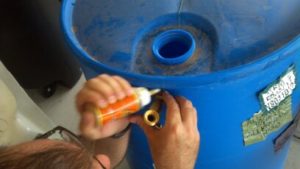 Insert Valves
Insert Valves
Place a gasket or o-ring on the spigot or valve and screw it into the drilled hole. When we had ours half-way inserted, we placed a little bit of gorilla glue on the screw threads and then tightened it down and positioned it to the correct angle. Gorilla glue expands, so a little bit does a long way. Allow the glue to dry for 24 hours before connecting the barrel to a water source.
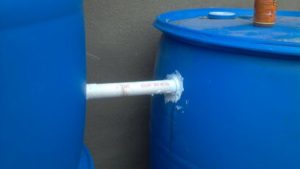 Connect PVC Pipe
Connect PVC Pipe
Use a saw or pipe cutter to cut PVC pipe to the desired length to extend the drip pipe so that it reaches the barrel. It should be long enough to extend several inches inside the barrel. Decide in advance how high the barrel will be elevated. It needs to be high enough to be able to place a bucket underneath the valve, or much higher if you will be attaching an overflow barrel to your system.
Use PVC glue to secure the pipe and allow it to dry for 24 hours.
If you will attach an overflow barrel, arrange the barrels so that the bottom of the first barrel is in line with the top of the second barrel. Both barrels should be elevated so that there is easy access to both spigots.
Attach the barrels with a short piece of PVC pipe. Place a rubber gasket or o-ring on each end of the pipe. Insert the pipe into both barrels and push the gaskets so that they butt up against the barrels. If there is any space between the hole and the pipe, use a screwdriver to push the gaskets into the spaces. Seal the pipe and gaskets with silicone calk and allow to dry for 24 hours.
Do not glue this pipe permanently to the barrels. You will want to make this connection easy to remove in case you need to separate the barrels for occasional cleaning. You can easily renew the connection with fresh gaskets and silicone.
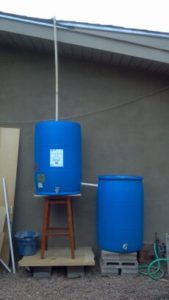 Test the System
Test the System
After all the glue and silicone has dried, insert the pipe and give it a test run. Since the drips slowly, it make take a while to know whether of not the system is working. Keep an eye on it, and repair any leaks with fresh silicone.
Our system is rather unsightly as it is. We will paint the barrels and the pipe the same color as the house and build a brick stand to replace the stool and the boards that currently support the top barrel. For now, it’s function over form, and it does a great job of water harvesting despite its appearance.
Rainwater Harvesting Resources
Rainwater Harvesting for Drylands and Beyond by Brad Lancaster
Rainwater Harvesting for Drylands and Beyond, Volume 2 Water Harvesting Earthworks by Brad Lancaster
Rainwater Harvesting and Use: Understanding the Basics by Anthony Zagelow
